
The thing about exponential growth is that it looks boring until suddenly it doesn't. The AI agents market sat at $5.40 billion in 2024, which sounds impressive until you realize it's headed for $50.31 billion by 2030. That's a 45.8% annual growth rate, the kind of number that makes venture capitalists spill their oat milk lattes.
But the real story isn't the money. It's what happens when software stops being something you use and starts being something that uses itself.
The current state of play
Right now, in 2025, the global AI agent market hits $7.63 billion. North America holds 40% of the global market share, because of course it does. What's genuinely surprising is that 85% of enterprises plan to adopt AI agents this year.
Not pilot. Not explore. Adopt.
When we first saw that number, we assumed it was the usual tech industry hyperbole. Then we looked at what happens when companies actually deploy these things: 55% efficiency gains, 35% cost reductions. Those aren't rounding errors. Those are the kinds of improvements that make CFOs religious.
The players and their games
Every tech giant wants to own this space, but they're taking wildly different approaches.
Microsoft decided subtlety was overrated. They jammed AI agents into everything Office touches, which is basically everything anyone does at work. Their September 2024 Microsoft 365 Copilot launch wasn't about adding features. It was about making the software anticipate what you need before you know you need it.
Salesforce, never one for understatement, had Marc Benioff declare this "The agent revolution is real" and comparable to the cloud revolution. When the guy who helped invent SaaS tells you something's going to be bigger than SaaS, it's worth paying attention.
Google does what Google does: push the technical boundaries while everyone else figures out the business model. OpenAI, Anthropic, and Cohere play the role of barbarians at the gate, forcing everyone to move faster than they're comfortable with.
The telling detail: By 2028, 33% of enterprise applications will have agentic AI built in, up from basically zero today. We're watching software eat itself and become something else entirely.
Three sectors where reality is already here
Customer service gets weird
The stat that breaks people's brains: AI agents handle up to 95% of routine customer inquiries. Not route them to the right department. Handle them. Completely.
Wiley provides the case study everyone will be citing for the next five years. They got a more than 40% increase in case resolution using Agentforce. Their previous bot was like comparing a flip phone to an iPhone. The new agents don't follow decision trees. They actually understand what people want and figure out how to deliver it.
The uncomfortable truth: most customer service interactions don't need human creativity or empathy. They need someone (or something) that can understand a problem and fix it. AI agents do this better than humans because they never have bad days.
Sales discovers leverage
83% of sales teams using AI report revenue growth, versus 66% without. That gap is only going to widen.
The magic happens in the multiplication of effort. One good salesperson becomes effectively ten good salespeople. AI agents qualify leads while you sleep, draft emails that sound like you wrote them (because they learned from the thousands you already wrote), and handle the administrative quicksand that drowns most sales processes.
For teams already swimming in AI productivity tools, agents represent the logical next step: from tools that help you work to tools that work for you.
Healthcare's reluctant revolution
90% of hospitals plan to adopt AI agents by 2025. Hospitals. The same institutions that still use fax machines and run Windows XP on critical systems.
The market tells the story: healthcare AI agents grow from $1.95 billion in 2022 to over $10 billion by 2030. When healthcare moves this fast on technology, something fundamental is shifting.
What changed? Healthcare finally found AI applications where errors hurt less than the status quo. Appointment scheduling, insurance verification, routine triage. The boring stuff that burns out staff and frustrates patients. AI agents handle it better because they don't need coffee breaks or get annoyed by the fifteenth person asking the same question.
The customization inflection point
Today's market splits between ready-to-deploy and build-your-own agents. The ready-made options from Zendesk, HubSpot, and others work like microwave dinners: fast, functional, and fine for basic needs.
But the build-your-own segment will grow fastest, for obvious reasons. Every business has accumulated decades of weird processes, edge cases, and "that's just how we do things here" requirements. Generic agents handle maybe 80% of what you need. For some companies, that's plenty. For others, that missing 20% contains everything that makes them special.
Custom agents learn your specific terminology, integrate with your Frankenstein tech stack, and understand why Sharon from accounting needs everything in triplicate. They become part of your organizational DNA rather than bolted-on accessories.
The forces at work
Three dynamics make AI agent adoption inevitable rather than optional:
Productivity math gets brutal. Teams can't hire their way to efficiency anymore. Labor costs too much, takes too long to train, and keeps quitting. Superhuman's State of Productivity & AI Report 2025 found AI saves professionals a full workday weekly. Agents multiply this by handling entire processes, not just discrete tasks.
Talent scarcity becomes permanent. The skills you need keep evolving faster than humans can learn them. AI agents offer a different solution: instead of finding perfect people, augment the imperfect ones you have.
Customers develop zero patience. Two out of three consumers expect instant issue resolution. Not fast. Instant. Human-mediated service can't deliver this consistently. AI agents can.
The problems nobody wants to discuss
Four challenges threaten to slow the agent revolution:
Integration remains genuinely hard. Making AI agents work with legacy systems is like teaching your grandmother's Ford Pinto to drive itself. Possible? Maybe. Pleasant? Never.
Data quality becomes destiny. AI agents need clean, structured, consistent data. Most organizations have data that looks like a teenager's bedroom. Fixing this is expensive, boring, and absolutely necessary.
The trust problem compounds. As agents handle more critical tasks, "I don't know why it decided that" becomes an unacceptable answer. Organizations need transparency, audit trails, and explainability. The technology isn't quite there yet.
Skills gaps create skills gaps. The same organizations that need AI agents most (because they can't hire enough people) also can't hire the people to implement AI agents. It's circular and frustrating.
What 2025-2030 actually looks like
The market grows from $7.84 billion in 2025 to $52.62 billion by 2030. Behind those numbers, three shifts reshape everything:
Vertical specialization wins. Generic agents give way to ones that deeply understand specific industries. A legal AI agent won't just schedule depositions. It'll understand jurisdiction, precedent, and why partners bill in six-minute increments.
Agent networks emerge. Today's agents work alone. Tomorrow's will collaborate like a well-trained team. Your email agent will check with your project management agent before promising deliverables. This sounds simple until you try to build it. The companies figuring out agent-to-agent protocols will own the next decade.
Interfaces disappear. Text prompts are training wheels. Future agents will infer what you need from context, behavior, and patterns. The best interface is no interface. We're watching AI workflow automation evolve from command-based to intention-based.
Try SuperhumanThe pragmatist's guide to starting
"2025 will mark the year" when AI proves ROI or dies. The companies succeeding share a pattern: they start specific, prove value, then expand.
Pick your most painful problem. Not your most interesting one. Your most painful one. The thing that makes good employees quit. The process everyone hates. The bottleneck that never goes away. Modern AI for efficiency works best when solving real pain.
Think systems, not tools. AI agents enable new workflows, not just faster old ones. The companies getting 10x improvements redesigned their processes around what agents make possible.
Adoption beats capability. A mediocre agent everyone uses beats a brilliant one gathering dust. User experience, training, and change management matter more than technical specifications.
Measure ruthlessly. Time saved, errors reduced, revenue increased, customers retained. If you can't measure it, you can't improve it, and you definitely can't justify expanding it.
The view from here
The AI agents market isn't experiencing growth. It's experiencing metamorphosis. The caterpillar (traditional software) and the butterfly (autonomous agents) are technically the same organism, but functionally they're different species.
Smart companies aren't waiting for perfect solutions. They're running small experiments, learning fast, and positioning themselves for a world where software doesn't just respond to commands but anticipates needs, handles complexity, and makes decisions.
Look at your Monday morning. Count the repetitive tasks. Note the context switching. Track the interruptions. Calculate the time spent on coordination versus creation. Each friction point represents an opportunity for AI agents to matter.
The winners won't be the companies with the most agents or the best agents. They'll be the ones who figure out how to make agents part of their organizational intelligence rather than just their tech stack.
The revolution already started. The only question is whether you're participating or watching.





